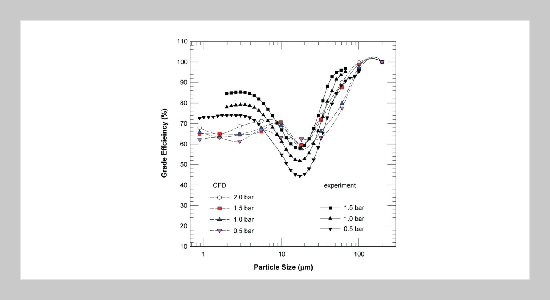REFERENCES
- [1] Yoshioka, N. and Hotta, Y., “Liquid Cyclone as a Hydraulic Classifier,” J Chem Eng Japan, Vol. 19, pp. 632�640 (1955).
- [2] Trim, D. S. and Marder, R. C., “Investigations of Hydrocyclones for Concentration of Cassava Milk,” Starch-Starke, Vol. 47, pp. 306�311 (1995).
- [3] Klimpel, R. R., “The Influence of Chemical Dispersant on the Sizing Performance of a 24-in Hydrocyclone,” Powder Technol., Vol. 31, pp. 255�262 (1982).
- [4] Dyakowski, T. and Williams, R. A., “Modelling Turbulent Flow within a Small-Diameter Hydrocyclone,” Chem Eng Sci., Vol. 48, pp. 1143�1152 (1993).
- [5] Yuan, H. D., Rickwood, T. C. S. and Thew, M. T., “An Investigation into the Possible Use of Hydrocyclones for the Removal of Yeast from Beer,” Bioseparation, Vol. 6, pp. 159�163 (1996).
- [6] Thew, M. T. and Smyth, I. C., “Development and Performance of Oil-Water Hydrocyclone Separators � A Review,” In: Innovation in Physical Separation Technologies, Pub. The Institution of Mining and Metallurgy, London, pp. 77�89 (1998).
- [7] Sinker, A. B., Humphris, M. and Wayth, N., “Enhanced Deoiling Hydrocyclone Performance without Resorting to Chemicals,” In: Paper SPE 56969 Presented at the Offshore Europe Conference, Aberdeen, Scotland (1999).
- [8] Wanwilai, K. E., Anotai, S. and Andrzej, F. N., “The Simulation of the Flow within a Hydrocyclone Operating with an Air Core and with an Inserted Metal Rod,” Chem Eng J., Vol. 143, pp. 51�61 (2008).
- [9] Sripriya, R., Kaulaskar, M. D., Chakraborty, S. and Meikap, B. C., “Studies on the Performance of a Hydrocyclone and Modeling for Flow Characterization in Presence and Absence of Air Core,” Chem Eng Sci., Vol. 62, pp. 6391�6402 (2007).
- [10] Kelsall, D. F., “A Study of the Motion of Solid Particles in a Hydraulic Cyclone,” Trans Instn Chem Engrs., Vol. 30, pp. 87�108 (1952).
- [11] Bergstrom, J. and Vomhoff, H., “Experimental Hydrocyclone Flow Field Studies,” Sep Purif Tech., Vol. 53, pp. 8�20 (2007).
- [12] Bergstrom, J., Vomhoff, H. and Soderberg, D., “Tangential Velocity Measurements in a Conical Hydrocyclone Operated with a Fibre Suspension,” Minerals Eng., Vol. 20, pp. 407�413 (2007).
- [13] Hsu, C. Y. and Wu, R. M., “Hot Zone in a Hydrocyclone for Particles Escape from Overflow,” Dry Tech., Vol. 26, pp. 1011�1017 (2008).
- [14] Pericleous, K. A. and Rhodes, N., “The Hydrocyclone Classifier � A Numerical Approach,” Int J Mineral Process, Vol. 17, pp. 23�43 (1986).
- [15] Hsieh, K. T. and Rajamani, R. K., “Mathematical Model of the Hydrocyclone Based on Physics of Fluid Flow,” Am Institute Chem Eng J., Vol. 37, pp. 735�746 (1991).
- [16] Medronho, R. A., Schuetze, J. and Deckwer, W. D., “Numerical Simulation of Hydrocyclones for Cell Separation,” Lat Am Appl Res., Vol. 35, pp. 1�8 (2005).
- [17] Wang, B., Chu, K. W. and Yu, A. B., “Numerical Study of Particle-Fluid Flow in a Hydrocyclone,” Ind Eng Chem Res., Vol. 46, pp. 4695�4705 (2007).
- [18] Wang, B. and Yu, A. B., “Numerical Study of the Gas-Liquid-Solid Flow in Hydrocyclones with Different Configuration of Vortex Finder,” Chem Eng J., Vol. 135, pp. 33�42 (2008).
- [19] Xu, P., Wu, Z., Mujumdar, A. S. and Yu, A. B., “Innovative Hydrocyclone Inlet Designs to Reduce Erosion-Induced Wear in Mineral Dewatering Processes,” Drying Tech., Vol. 27, pp. 201�211 (2009).









